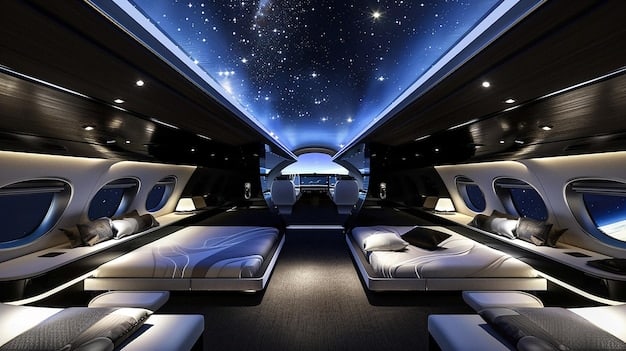Space Tourism’s Impact: Reshaping the US Travel Industry

The growing interest in space tourism is poised to significantly impact the US travel industry, potentially creating new markets, driving innovation, and requiring adaptation from existing travel businesses to accommodate this emerging sector.
The allure of space has captivated humanity for centuries, and now, with advancements in technology, it’s tantalizingly close to becoming a reality for a select few. But how will this surge in interest in space tourism impact the US travel industry?
The Dawn of Space Tourism: An Overview
Space tourism, once a distant dream, is rapidly approaching commercial viability. As companies like SpaceX, Blue Origin, and Virgin Galactic push the boundaries of space travel, the US travel industry finds itself on the cusp of a new era.
But what exactly constitutes space tourism, and how does it differ from traditional travel experiences?
Defining Space Tourism
Space tourism refers to recreational travel beyond Earth’s atmosphere. This can range from suborbital flights offering a few minutes of weightlessness to orbital stays lasting several days or even weeks.
The Key Players in Space Tourism
Several companies are vying for a piece of the space tourism pie:
- SpaceX: Known for its ambitious goals, SpaceX aims to offer orbital and even lunar tourism opportunities.
- Blue Origin: Focusing on suborbital flights, Blue Origin promises a brief but exhilarating experience of weightlessness and a view of Earth from space.
- Virgin Galactic: Similar to Blue Origin, Virgin Galactic is developing reusable spacecraft for suborbital tourism.
The nascent space tourism industry presents both opportunities and challenges for the established US travel sector. Understanding these factors is crucial for navigating this exciting new landscape.

Potential Economic Benefits for the US Travel Industry
The rise of space tourism could inject significant capital into the US economy, creating new jobs and stimulating innovation across various sectors.
From infrastructure development to specialized training programs, the economic benefits could be far-reaching.
Job Creation
The space tourism industry will require a skilled workforce, creating jobs in engineering, aerospace, hospitality, and marketing. These jobs will likely be concentrated in areas with existing aerospace infrastructure, but their impact will be felt nationwide.
Stimulating Innovation
The demand for space travel will drive innovation in related technologies, such as propulsion systems, life support, and advanced materials. This innovation could spill over into other industries, boosting US competitiveness in the global market.
Attracting High-Value Tourists
Space tourism is inherently expensive, attracting high-net-worth individuals who are likely to spend generously on pre- and post-flight activities, such as luxury accommodations, exclusive tours, and specialized medical services. This could provide a significant boost to the US luxury travel market.
However, realizing these economic benefits will require strategic planning and investment from both the public and private sectors.
Challenges and Concerns Facing the US Travel Industry
While space tourism holds immense potential, it also presents several challenges for the US travel industry. Safety concerns, environmental impact, and ethical considerations must be addressed to ensure the sustainable development of this sector.
Addressing these challenges proactively will be essential for building public trust and ensuring the long-term viability of space tourism.
Safety Regulations and Risk Management
Ensuring the safety of space tourists is paramount. The US government, through agencies like the FAA, must establish clear safety regulations and oversight mechanisms. Moreover, travel companies need to implement robust risk management protocols to mitigate potential hazards.
Environmental Impact of Space Launches
Space launches can have a significant environmental impact, including air and noise pollution. The industry must invest in cleaner propulsion systems and sustainable launch practices to minimize its carbon footprint. This includes:
- Developing reusable rockets to reduce waste.
- Using alternative fuels to minimize emissions.
- Implementing noise reduction technologies to mitigate the impact on surrounding communities.
Ethical Considerations and Accessibility
The high cost of space tourism raises ethical questions about accessibility and exclusivity. Efforts should be made to make space travel more inclusive and accessible to a wider range of people, perhaps through subsidized programs or lottery systems.
Ultimately, a balanced approach is needed to harness the benefits of space tourism while addressing its potential drawbacks.

Adapting Infrastructure and Services for Space Tourists
The US travel industry needs to adapt its infrastructure and services to cater to the unique needs of space tourists. This includes developing specialized training facilities, medical support systems, and customized travel itineraries.
Investing in these areas will be crucial for attracting space tourists and providing them with a seamless and memorable experience.
Specialized Training Facilities
Space tourists will require specialized training to prepare them for the physical and psychological challenges of space travel. This training could include:
- G-force simulations.
- Weightlessness training.
- Survival skills instruction.
Medical Support Systems
Access to medical care is essential for space tourists, both before, during, and after their journey. This may involve establishing specialized medical facilities near launch sites and developing telemedicine capabilities for in-flight support.
Customized Travel Itineraries
Space tourists are likely to be discerning travelers with specific interests and preferences. Travel companies need to develop customized itineraries that cater to their individual needs, offering unique experiences both on Earth and in space.
By investing in these areas, the US travel industry can position itself as a leader in space tourism and capture a significant share of this emerging market.
The Role of Government and Regulations
The US government plays a critical role in shaping the future of space tourism. Clear and consistent regulations are needed to ensure safety, protect the environment, and promote fair competition.
Collaboration between government and industry is essential for creating a supportive regulatory environment that fosters innovation and growth.
Establishing Safety Standards
The FAA is responsible for regulating the safety of commercial spaceflights. It needs to establish clear safety standards for spacecraft design, operations, and crew training. These standards should be regularly reviewed and updated to reflect the latest technological advancements.
Protecting the Environment
The government must also address the environmental impact of space launches. This could involve setting limits on emissions, promoting the use of cleaner fuels, and requiring environmental impact assessments for proposed launch sites.
Promoting Fair Competition
The government should promote fair competition in the space tourism industry by ensuring that all companies have equal access to launch sites, airspace, and other essential resources. This will help to foster innovation and prevent monopolies from forming.
Ultimately, a well-defined regulatory framework is essential for creating a stable and predictable environment for space tourism to thrive.
Marketing and Promoting Space Tourism to US Travelers
Effectively marketing space tourism to US travelers will be crucial for driving demand and achieving commercial success. Travel companies need to highlight the unique experiences and benefits of space travel, while also addressing safety concerns and managing expectations.
A well-crafted marketing strategy can help to position space tourism as a desirable and attainable travel option for a growing segment of the population.
Highlighting Unique Experiences
Space tourism offers experiences that are simply not possible through traditional travel. Marketing campaigns should emphasize the awe-inspiring views of Earth, the thrill of weightlessness, and the opportunity to be among the first to explore the final frontier. Consider showcasing:
- Stunning visuals of Earth from space.
- Testimonials from early space tourists.
- Interactive simulations of the space travel experience.
Addressing Safety Concerns
Safety is a major concern for potential space tourists. Marketing materials should address these concerns directly, highlighting the rigorous safety standards and protocols in place. Transparency and open communication are key to building trust.
Managing Expectations
It’s important to manage expectations about the space tourism experience. Emphasize that space travel is still in its early stages and that there may be some limitations or inconveniences. Honesty and realism will help to avoid disappointment and build long-term customer loyalty.
By effectively marketing space tourism, the US travel industry can tap into a new and lucrative market, driving growth and innovation for years to come.
The Future of Space Tourism and its Lasting Legacy
Space tourism is still in its early stages, but its potential impact on the US travel industry is undeniable. Over time, as technology advances and costs decrease, space travel is likely to become more accessible to a wider range of people.
This could have profound implications for how we view travel, exploration, and our place in the universe.
Increased Accessibility
As technology matures and competition intensifies, the cost of space tourism is likely to decrease, making it more accessible to a larger segment of the population. This could lead to the development of new and innovative travel packages that combine space travel with traditional tourism experiences.
Technological Advancements
Continued advancements in technology will make space travel safer, more comfortable, and more efficient. This could lead to the development of larger spacecraft, longer duration flights, and even the possibility of space-based hotels and resorts.
Inspiring Future Generations
Space tourism has the potential to inspire future generations of scientists, engineers, and explorers. By making space travel a reality, the industry can help to ignite a passion for STEM fields and foster a sense of wonder and curiosity about the universe.
The legacy of space tourism could extend far beyond the travel industry, shaping our understanding of the cosmos and inspiring innovation for decades to come.
| Key Point | Brief Description |
|---|---|
| 🚀 Economic Boost | Space tourism can create jobs and stimulate related innovation. |
| 🌎 Environmental Concerns | Reducing emissions and promoting sustainable launch practices are crucial. |
| 🧑🚀 Safety Regulations | Clear safety regulations are needed for spacecraft, operations, and training. |
| 🏨 Infrastructure Adaptations | Specialized training and medical facilities are needed to accommodate space tourists. |
Frequently Asked Questions (FAQ)
▼
Space tourism involves recreational travel beyond Earth’s atmosphere. This can include suborbital flights, orbital stays, and even lunar missions, catering to both short and extended experiences.
▼
Key players include SpaceX, known for its ambitious orbital and lunar tourism plans; Blue Origin, focusing on suborbital flights providing weightlessness; and Virgin Galactic, also developing reusable spacecraft for suborbital experiences.
▼
Space tourism can inject significant capital into the US economy by creating jobs in aerospace and hospitality, driving innovation in related technologies, and attracting high-value tourists who spend generously.
▼
Challenges include ensuring passenger safety through stringent regulations, minimizing environmental impact from launches, and addressing ethical concerns regarding accessibility and potential exclusivity of space travel opportunities.
▼
The industry can adapt by developing specialized training facilities, establishing robust medical support systems, and creating customized travel itineraries. These actions will accommodate and attract space tourists, enhancing their overall experience.
Conclusion
As the dream of space tourism inches closer to reality, the US travel industry stands on the brink of a potentially transformative era. While challenges certainly exist, the opportunities for economic growth, technological innovation, and inspiring future generations are immense. By proactively addressing safety concerns, mitigating environmental impacts, and adapting infrastructure to meet the unique needs of space travelers, the US travel industry can solidify its position as a leader in this exciting new frontier. The journey to the stars is just beginning, and its impact on the US travel landscape promises to be profound.





